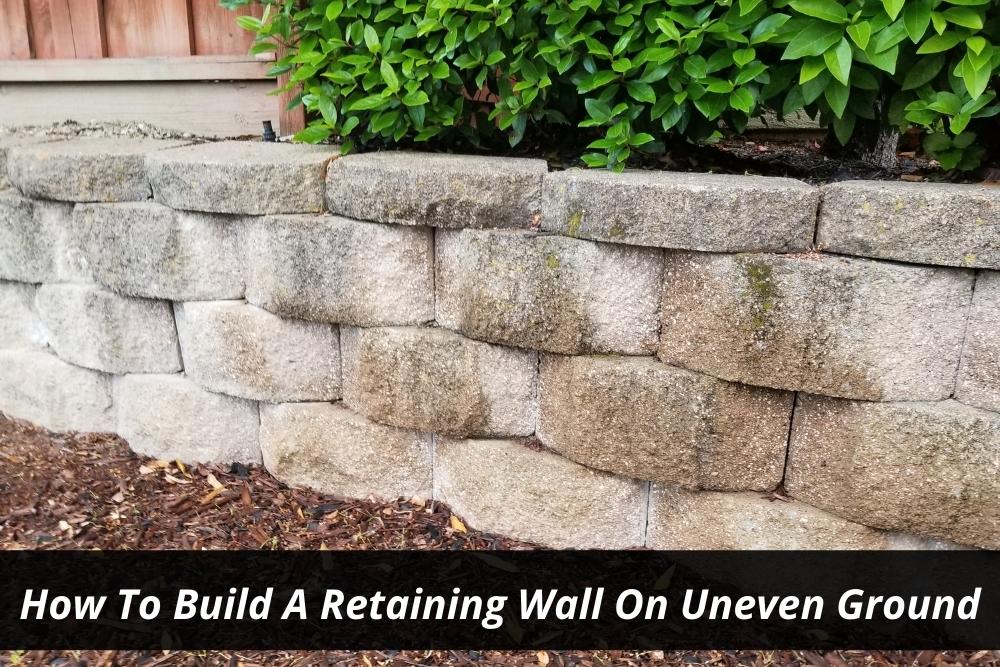Building a retaining wall on uneven ground can be a challenging task, but it is definitely possible with the right tools and techniques. In this article, we will show you how to build a retaining wall on uneven ground, step by step.
The first thing you need to do is to excavate the area where the retaining wall will be built. Make sure that the excavation is deep enough so that the foundation of the wall will be built on solid ground.
Once the excavation is complete, you need to install a drainage system at the base of the excavation. This will help to prevent water from pooling around the base of the retaining wall and causing it to collapse.
Next, you need to lay down a layer of gravel at the base of the excavation. This will help to provide a stable foundation for the retaining wall.
Now, you can begin to build the actual retaining wall. You will need to use concrete blocks or bricks to construct the wall. Make sure that the blocks or bricks are properly interlocked so that they are strong enough to support the weight of the soil behind them.
Once the retaining wall is complete, you need to backfill the excavation with soil. Make sure that the soil is compacted properly so that it will not settle and cause the retaining wall to collapse.
Things you need to consider before building a retaining wall on uneven ground
Building a retaining wall on uneven ground can be a challenging task, but with careful planning and execution, it can be done successfully. There are a few things you need to consider before starting such a project:
- The first thing you need to do is determine the reason why you want to build the retaining wall. Is it for aesthetics or functional purposes? If it’s for looks, then you have more leeway in terms of design and materials. However, if the purpose of the wall is to hold back soil or water, then it needs to be designed and built accordingly.
- Another important factor to consider is the height of the retaining wall. The taller the wall, the more pressure it will be under and the more likely it is to fail. As such, it’s important to make sure the wall is tall enough to do its job, but not so tall that it’s unstable.
- The type of material you use for the retaining wall is also very important. Different materials have different strengths and weaknesses, so it’s important to choose one that is appropriate for the job at hand. Common materials used for retaining walls include concrete, stone, and wood.
- The slope of the ground is also something you need to take into account. If the ground is too steep, then the retaining wall will be under too much pressure and may not be able to hold back the soil or water effectively. On the other hand, if the ground is too flat, then the wall may not be necessary at all.
- Finally, you need to consider the cost of building the retaining wall. Different materials and designs will have different price tags, so it’s important to choose something that fits your budget.
Building a retaining wall on uneven ground can be a challenging but rewarding task. By taking the time to plan and consider all of the factors involved, you can ensure that your retaining wall is both effective and stylish.
The different types of retaining walls you can build on uneven ground are:
- Gravity walls – these are the most common type of retaining wall and are built using gravity to hold the wall in place. The weight of the wall is what keeps it from moving.
- Cantilevered walls – these walls are held in place by their own weight and the weight of the soil behind them. They’re often used for taller walls or when there isn’t a lot of space to build a gravity wall.
- Anchored walls – these walls are anchored into the ground with cables or rods to keep them from moving. They’re often used in seismic areas or when there’s a lot of water pressure behind the wall.
- Soil-nailed walls – these walls are built by drilling into the ground and inserting rods or cables into the holes. The rods or cables are then covered with concrete or grout to hold the wall in place.
- Sheet pile walls – these walls are made of interlocking sheets of metal, wood, or plastic that are driven into the ground. They’re often used in areas where there’s a lot of water or when the soil is very loose.
Building a retaining wall on uneven ground can be challenging, but it’s definitely possible with the right type of wall and some careful planning. Talk to a professional if you’re not sure which type of wall is best for your project.
Tips for maintaining your retaining wall
If you have a retaining wall on your property, it’s important to keep it in good condition. Retaining walls can be made from various materials, including concrete, stone, and wood. Here are some tips for maintaining your retaining wall:
- Inspect your retaining wall regularly for cracks or other damage. repaired promptly to prevent further damage.
- Make sure that the drainage system around your retaining wall is functioning properly. Repair any clogged or damaged drains to prevent water from building up behind the wall.
- Check the soil behind the retaining wall for signs of erosion. If the soil is eroding, it can put pressure on the retaining wall and cause it to collapse.
- If you have any plants growing near your retaining wall, make sure that their roots are not damaging the wall. Roots can grow into cracks in the wall and cause instability.
- Regularly trim any trees or shrubs near your retaining wall. Overhanging branches can fall and damage the wall, and tree roots can destabilize the soil behind the wall.
- If you live in an area with earthquakes, have your wall checked by a professional to make sure that it meets local building codes for earthquake safety.
Keep these tips in mind to help keep your retaining wall in good condition. If you have any concerns about the stability of your retaining wall, contact a professional for an inspection.

